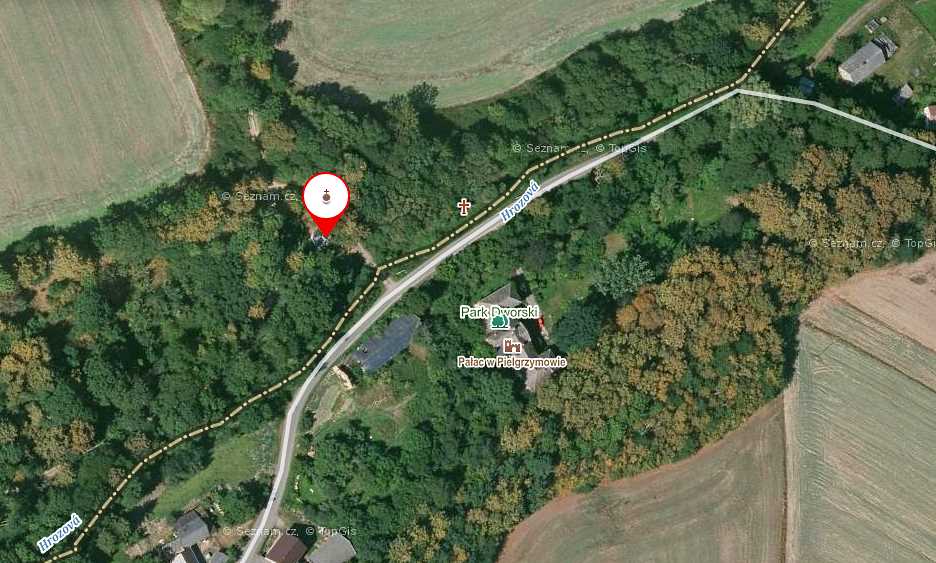Poland briefly invaded the Czech Republic, and prevented Czechs from going to a chapel from the end of May to early June. The Czech side says it is still waiting for an official statement from Poland.
Polish troops had been guarding the border with the Czech Republic’s Moravia-Silesia region since the start of the coronavirus crisis, which stopped most international travel and placed restrictions on the free movement of people.
PARTNER ARTICLE
At the end of May the Polish troops crossed the Hrozová stream that marks the border and went several dozen meters into the Czech Republic, setting up a checkpoint and a camp in the former village of Pelhřimovy, near the town Slezské Rudoltice.
All the remains of the Czech village is a few mostly dilapidated structures including a church, a chapel and a cemetery. On the Polish side of the stream there is a village called Pielgrzymów, which is still in use.
The Polish troops, armed with submachine guns, apparently were on the wrong side of the border for up to two weeks. Why the invasion happened, how long it lasted and how it was finally resolved is still far from clear, as both sides tell conflicting stories.
The Czech Foreign Ministry said the Polish Army left only after the Czech Embassy in Warsaw intervened to demand an explanation. The Polish Foreign Ministry claims that no official communications were received either in Warsaw or at the Polish Embassy in Prague.
The soldiers set up a checkpoint in front of the ruins of the St Anne Chapel on the Czech side of the stream, and allegedly forbid Czechs to enter the chapel or take any photographs.
An expert, who had been supervising chapel repairs, went there May 28 to get photographic documentation of how the plaster had been holding up. Polish soldiers forbade him to photograph or enter the chapel, according to Czech news server Denik.cz, which broke the story.

An environmental group, Hnutí Duha Jeseníky (Jeseník Rainbow Movement) had planned a group visit to the chapel in early June, but were turned away by the Polish soldiers as well, The soldiers were apparently not willing to listen to anyone trying to explain they were in the wrong country.
“When a soldier with a submachine gun in a foreign army uniform orders you, it’s a horrible experience. They didn’t let me get closer than 10 meters. Why does the Polish Army decide where I can go in the Czech territory and where not? The soldiers did not discuss their authority for the mission in the Czech Republic with me. Not even who can allow us to visit the chapel,” Ivo Dokoupil from Hnutí Duha Jeseníky told Denik.cz.
The mayor of the town of Slezské Rudoltice, Mojmír Pargač, said that he had not been consulted about the occupation of the chapel, which is on land the town owns.
Even after the mistake had been pointed out, the Polish soldiers remained for several days, but allowed some visits to the chapel. The regional Czech Police eventually came and ordered the Polish soldiers to leave, according to the BBC. The Czech Police are overseen by the Czech Interior Ministry.
The Polish Ministry of National Defense admitted that Polish soldiers have been helping the Border Police, but the invasion was not planned. “The location of the post was the result of a misunderstanding, not a deliberate act, and was immediately corrected. It is not true that Polish soldiers forbade taking pictures of the shrine, but they asked people not to photograph the post itself,” the Polish ministry said in a message to regional Polish newspaper Wiadomości Gazeta.
“The Polish Army makes every effort to ensure the security of borders and Polish citizens in a difficult fight with the opponent, which is the coronavirus. Every day, several thousand soldiers perform tasks aimed at limiting the spread of the virus,” the Ministry of National Defense added.
The Polish Foreign Ministry told US public broadcaster NPR that the incident was settled quickly. “According to our information, the case was discussed by the authorities responsible for border protection on the Polish and Czech sides. In the spirit of good Polish-Czech relations, we believe that this was only a minor misunderstanding that was quickly cleared up,” they said.
The Czech side is not so willing to brush the incident aside. “Our Polish counterparts unofficially assured us that this incident was merely a misunderstanding caused by the Polish military with no hostile intention, however, we are still expecting a formal statement,” a Foreign Ministry spokesperson told CNN.
The border between Poland and what is now the Czech Republic has been in dispute before. In January 1919, there was the Polish–Czechoslovak War, also called the Seven-Day War, concerning the border in Cieszyn Silesia. There were further disputes during 1938 regarding a small area with a Polish majority. In 1958 the border was set back to what it had been on January 1, 1938. Some minor adjustments were made after that for technical reasons.












 Reading time: 4 minutes
Reading time: 4 minutes 

























